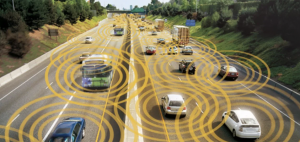Car 2 Car Communications & Location Services

Every vehicle receives as much information as possible from every other vehicle. This includes route characteristics, traffic conditions and also information on the weather. With the aid of this transmitted information, the car can react to the current traffic situation. In this scenario, the more cars there are the greater the information density and the more reliable and better the information is (swarm intelligence).
Recently the U.S. auto-safety regulators are proposing new rules requiring auto manufactures to adopt crash-avoidance technology that allows all new vehicles to inter-communicate with each other, this will facilitate the development of self-driving cars.
The promise of vehicle-to-vehicle communications is clouded by issues regarding current radio-based technology versus future 5G cellular networks. One example is device-to-device communication. This technology bypasses network infrastructure so that, for example, cars and pedestrians’ smartphones can communicate directly to avoid possible accidents.
This requirement of so-called vehicle-2-vehicle connectivity — simply called V2V in industry talk. This is soon to be mandated on all consumer vehicles within about five years. This is critical to the development of a new age of cars that can avoid accidents by wirelessly monitoring each other. V2V technology uses short-range radio communication to allow vehicles to identify each other’s speed, location, direction and acceleration or braking, within a radius of about 300 meters or o.
These pending mandates are form both US Dept. of transportation and National Highway Traffic Safety Administration toward its goal of eliminating the number of accidents today that were over million in 2015 and even more in 2016.
Car-to-car communication, often refereed to as vehicle-2-vehicle communications uses position, speed, steering-wheel angle, brake status, and other data to other vehicles within a few hundred meters. The other cars can use such information to share information of what’s unfolding around them, revealing trouble that even the most careful and alert driver, or the best sensor system, would miss or fail to anticipate therefore a major enhancement.
Car-to-car communication should also have a bigger impact than the advanced vehicle automation technologies that have been more widely heralded. Though self-driving cars could eventually improve safety, they remain imperfect and unproven, with sensors and software too easily affected by poor weather, unexpected obstacles or circumstances, or heavy traffic city driving. The technology that warned of the impending collision will start appearing in cars in just a couple of years. Called car-to-car communication, it lets cars broadcast their position, speed, steering-wheel position, brake status, and other data to other vehicles within a few hundred meters. The other cars can use such information to build a detailed picture of what’s unfolding around them, revealing trouble that even the most careful and alert driver, or the best sensor system, would miss or fail to anticipate.
Already many cars today have instruments that use radar or ultrasound to detect obstacles or vehicles. But the range of these sensors is limited to range of only just a few car lengths, and they cannot see past the nearest obstruction.
Car-to-car communication should also have a bigger impact than the advanced vehicle automation technologies that have been more widely heralded. Though self-driving cars could eventually improve safety, they remain imperfect and unproven, with sensors and software too easily hampered by poor weather, unexpected obstacles or circumstances, or complex city driving
The Company’s technology is grounded in the field of artificial intelligence and, in particular, the cutting-edge study of SWARM Intelligence (a form of intelligent computing), the next generation of technologies modeled after the behavior of decentralized biological systems, such as insects. SWARM Intelligence (SI) utilizes certain systems in nature, such as ants in a colony, harness a powerful, leaderless collective intelligence that leverages the simple independent intelligence of its numerous agents into goal oriented systems more efficiently and robustly than centrally-controlled systems.
